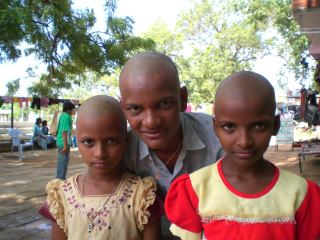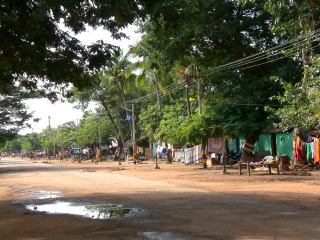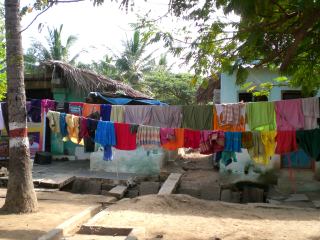Part I: The Family Headshave
In Hampi, we stopped at a tiny barber shop so that Marc could get a shave and a haircut for two bits (literally). I had the camera ready to record the straight-razor shave but was completely distracted by the anxious, little girl sitting in the chair next to Marc. She had a glossy, black head of pretty hair which, without hesitation or ceremony, the barber wetted and began shaving with a straight razor. From part to nape, the hair fell away and onto the floor.
Following her, as the youngest, her brother and sister took their turns before their monther and father. The whole family then went to bathe in the river which, along with the shaving, we were told was part of a ritual pilgrimage.

Part II: What Is That?
It is a six hour journey by passenger train from Ajmer to Jaipur and for two of us to travel, it was less than $2 CAD. There are bench seats and open windows and fans for when the heat is unbearable, but those were all turned off, and the windows were closed when we travelled. The people in the cars were all wearing toques and scarves and were draped with blankets.
There was a friendly fellow that sat across from us who spoke way more English than we spoke Hindi. He asked where we were from, are we married and is it a ‘love’ marriage, and did we like India. He helped us to buy chai and told us that, regrettably, we had been cheated when we bought our bananas on the platform: we had paid Rs.20 (less than $0.50) when we should have only been charged Rs.10. He said he was sorry that we had been cheated.
Shortly thereafter, we pulled our our iPods and the following conversation ensued:
“Oh, FM radio, yes?”
“No, no, it’s an iPod.”
“Oh yes, a cassette player.”
“No, it’s an iPod, like a computer- see?” I show him my Nano.
“Oh, FM radio.”
“No, look, it’s like a computer that plays music.”
I gave him the earphones and he listened to a minute of music, nodding, but still not really understanding.
“Oh, okay” he says.
Part III: Newspaper
Apart from its primary function of reporting news, a newspaper in India can be so much more. It is a towel with which to wash windows, a food wrapper, an origami-ed spice pouch, a paper towel, a blanket, a floor mat, a fly swatter, a napkin and a plate. In a country that hasn’t yet embraced the waste management practices of reduce or recycle, re-use is second nature.
Part IV: The Cleaning
Weeks after this occurance, I am still a bit astonished as to how it occurred.
I was walking down the beach to meet Marc at our hut in Goa, South India. I was carrying my sandals, walking in the surf and nodding ‘hello’ to the people I passed. One man, an Indian, stopped and turned when I said hello. He pointed to the side of my sunglasses and said something in Urdu. My immediate thought was that there was a bug on me and that he was warning me. I took off the sunglasses and started examining them but he pointed, again, to the side of my face. I started feeling around my temple but he approached and touched my ear for a couple of seconds. When he drew back, he held a tiny, elongated spoon in his hand with something yellowish on the end. He pushed it off with his finger and said, “Wax”.
Suddenly, I understood that he had quickly scooped my ear for wax. Before I even had a chance to get over my astonishment, he produced a card which stated that he was a certified Middle Ear Cleaner and he explained that he could clean my ears for 200 rupees. I was aghast and almost at a loss for words; how did this man put a spoon in my ear without me feeling it? I emphatically declined his services and rushed away.
Part V: ATM
 In the one-horse town of Hampi, Marc and I decided to get some money. We walked 500m to arrive at the only bank in this village of 3000 people. We weren’t desparate for the cash, and could’ve gone a bit further afield to visit an ATM, but thought we’d give the local branch a shot.
In the one-horse town of Hampi, Marc and I decided to get some money. We walked 500m to arrive at the only bank in this village of 3000 people. We weren’t desparate for the cash, and could’ve gone a bit further afield to visit an ATM, but thought we’d give the local branch a shot.
We walked into the offices and asked if we could “get some money”. The man at the counter said they were closed, yet the doors were open, the lights were on and the office was filled with staff about their business. We looked at each other, and then back at the fellow, and then Marc asked, “OK, what time do you open tomorrow?” Immediately, the fellow started talking with his colleagues. Ninety seconds pass and we are still standing there, so Marc asks again, “What time do you open tomorrow?” and the man says, “Yes, we are discussing.”
So we wait. Four minutes pass and he then asks us what we wish to do. We say, again, that we wish to withdraw some money. And he says, “OK, sit down.”
So we sit. Another man pulls out a ledger and asks for a credit card and passport. Marc produces both and the man meticulously copies the details of each into this dusty ledger. There is more discussion between colleagues. Tea is served. The waiting continues. Meanwhile, a small crowd of people has gathered outside the door of the bank to watch the foreigners. More and more people accumulate.
Finally, another man appears with a stack of bills which, when he places them on the desk in front of us, measures more than six inches tall. He explains that he can only give us 50’s and 100’s because that’s all they have. As the only bank in town.
Without any other option, we shrug and take a fistfiull of cash in each hand, which we “hide” in our pockets as we push past the spectators and make our way as quickly and nervously as possible to our hotel. Apart from the pig we saw eating a dead cat, no incidents ensued.

We forgot to write about the Taj Mahal!
